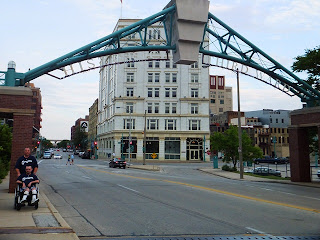It’s the city beer made famous, breweries and bars dot the landscape. Our latest escapades return us to the shores of Lake Michigan and Milwaukee, Wisconsin.
After flying all day on Southwest and picking up a Ford Escape from Thrifty Rent-a-car at the airport, we eventually find our hotel, The Ambassador Hotel - Milwaukee , on Wisconsin Avenue adjacent to Marquette University.
, on Wisconsin Avenue adjacent to Marquette University.
Watch the Video!
The third floor room features a king size bed, a queen size sofabed, flat screen TV, wifi and wired free internet, basic wet bar, robes, ironing board and iron, accessible restroom featuring a barred bathtub with seat or roll in shower.
Upon check-in, we’re offered a deal…$7.95 for breakfast vouchers. Seeing their site beforehand, and knowing that breakfast here went for twice as much, we snapped some up. We’re glad we did because breakfast is in their beautiful restaurant with entrees such as spinach omelets, pancakes, bacon and eggs, and delicious waffles covered with fruit served to your table by actual waiters. No warmed up breakfast bar entrees here.
Our main reason for being here is to notch another point for our seemingly never-ending quest to see every Major League Baseball stadium. We have tickets for tomorrow’s game but today is for exploring the city. First up…as all our friends who have experience here have been telling us…we have to go to the Third Ward.
This is an old area, burned down in a big fire long ago and rebuilt into an Italian neighborhood, that is being gentrified. While some buildings are still waiting for their time in the redevelopment spotlight, most of the area has been spiffed up and is home to nice little boutiques, restaurants, bars, and anchored by the Milwaukee Public Market.
It’s also the south end of the Milwaukee Riverwalk, a three mile long accessible walk along the Milwaukee River that takes you through the highlights of downtown.
We start filming (see the video above) and soon run into another crew doing the same thing on the river side of the Milwaukee Ale House. It’s a great walk that we’ll take full advantage of later. Tonight, we’ll have dinner at Benelux, a restaurant and bar dedicated to all the good food and drink of the European lowlands.
And what food it is…Tim and I have their very good burger served with Belgian frittes and a beer palette (four beers served on a wooden palette) made up of Belgian strong ales. Letty has the Friday fish fry with Ichtagem’s sour red Flemish ale. That’s after a very tasty starter of tater tots filled with brie and accompanied by a Sriracha garlic mayo dipping sauce. It is very good and we vow to come back again before we leave and dig a little deeper into the menu.
An aimless trip south of town takes us to St. Francis, home of a big monastery, a bunch of bars, and a nice beach. It’s a nice place to stretch our legs a little, take some pictures, and just relax before heading back into town.
All in all, it’s a fun but short overview of the town we’ll be spending the next four days in. Stay tuned for more fun, drinking, eating, baseball, and cheeseheads here in what will turn out to be one of the best destinations we’ve been to.
-Darryl
Copyright 2012 - Darryl Musick
All Rights Reserved
Photos by Letty Musick
Copyright 2012 - Letty Musick
All Rights Reserved















































